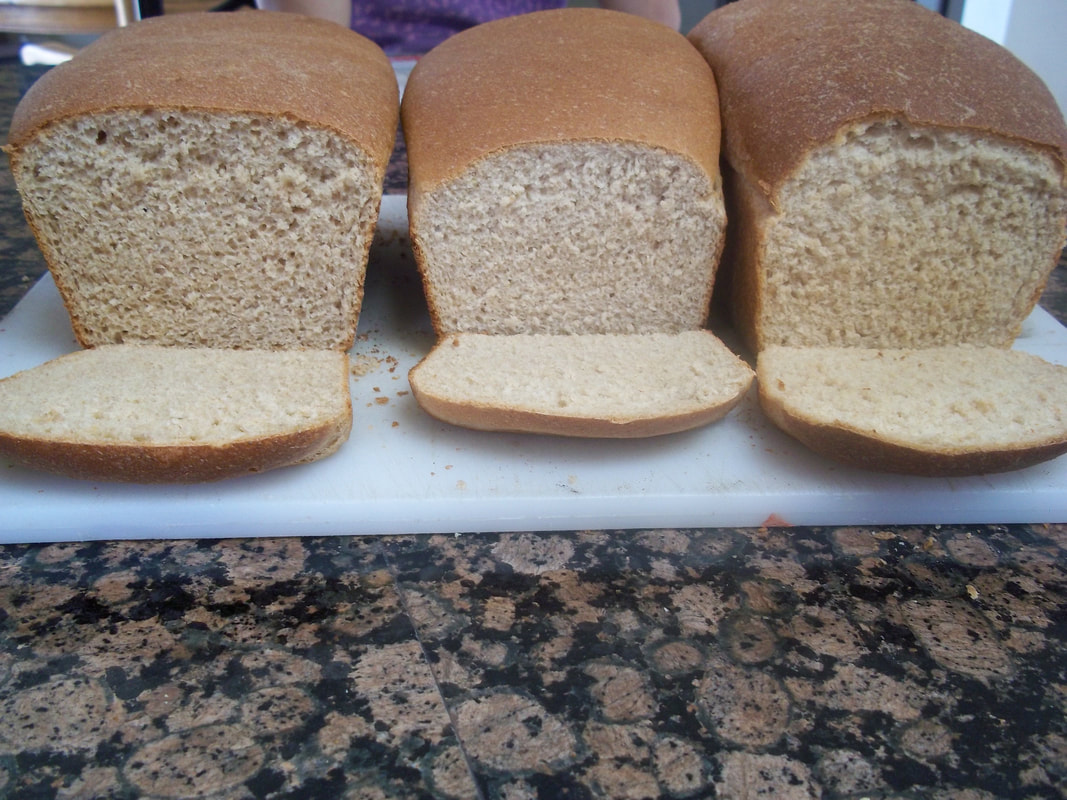My mom taught all of us kids how to make bread when we were young. I still use her recipe today; it has good flavor, is immensely adaptable, and works well with quite a bit less yeast per loaf needed than many other recipes call for. That recipe is found on my website under “Making Bread”. There are two amounts of ingredients- one for a two-loaf batch, and another for a six-loaf batch (the size that fills my oven-- because it's the same amount of dishes and time to make 6 as it is to make 1).
Wait until the bread is cool before slicing and bagging it. The exception is the loaf you eat while it's still hot! But be patient for 10-20 minutes after it's out of the oven; it continues to cook during that time. It will mash if you slice before then. Bread freezes exceptionally well, so I always put in the pantry only the bread we'll eat in the next three days, when fresh bread is at its best. The rest goes into the freezer; it will taste fresh-baked when you thaw it later. (The best way to thaw is in its bag at room temperature for a few hours. The next best way-- which we do more often-- is to put it in the microwave for 60 seconds. Be sure to remove any metal twist tie on the bag!)
This recipe works whether you’re making it in a big bowl with a strong wooden spoon, or if you have a stand mixer. (Mom made me learn initially with the bowl and spoon, because, she said, “You won’t always have a mixer.” That turned out to be true. I made my bread all through college with nothing but a bowl and wooden spoon.) If you’re new to making bread, make your first few batches with all white flour. It’s easier to make good white bread with than it is to make good whole wheat bread.
A new electric grain mill generally costs somewhere around $200. There are hand mills sold for much less money – around $80—but it’s a whole lot of work and time to get enough flour for a batch of bread with one of those. I like having one as emergency backup, but not for normal use. The electric mill can give you finer flour anyway.
If you want to start using your wheat for bread and don’t have a mill, try this recipe: Really Good Whole Wheat Bread Without a Grain Mill. It's the bread version of Blender Pancakes; this kind of pancake recipe can also be found in the Wooden Spoon: Wheat section, and in the Bee Prepared Pantry Cookbook.
What if you don’t have yeast? Use a sourdough start or “everlasting yeast” to leaven it. (Maybe that should be the topic for next week’s post—What do you think?)
What if I ruin the batch of bread?
First of all, everyone makes a ‘bad’ batch every now and then. See if you can figure what went wrong, and learn from it. Meanwhile, here are some common problems and how to use the bread anyway. Ruined doesn’t need to mean wasted.
BURNT BREAD- Scrape off the darkest parts, or cut it away in the thinnest slices you can manage.
BREAD WON’T RISE- Make fried scones. If you’re unfamiliar with the term, they’re a kind of yeast-raised Indian fry bread or sopapillas. Here in Utah, we just call them ‘scones’. Heat a 1-2” deep layer of cooking oil to 350 degrees, pinch off golfball-sized pieces of dough and stretch or roll them about ¼” thick. Fry 3 or 4 at a time, turning them over after about a minute. Drain on paper towels and serve as the base for Navajo Tacos, or with butter and honey or jam.
BREAD IS UNDERCOOKED- if the bread is still hot, put it back in the oven for another five minutes. Check again. Cook longer if needed. If the bread was no longer hot when you discovered the problem, slice it a little thinner than you normally would, and toast it. Now it’s cooked.
BREAD IS CRUMBLY. (Or stale)- This is a problem you see only after it has cooled; warm bread is almost always amazing and not crumbly. The solution next time is to get the gluten to develop better. (Unless the problem is the bread is several days old and dried out. These solutions still apply.)
• Make it into French toast, egg toast, or bread pudding. (Try Caramel Pumpkin Bread Pudding or Pineapple Coconut Bread Pudding!)
• Use it for sandwiches with a creamy filling, like egg salad or chicken salad.
• Use it up sooner than usual and freeze everything that you won’t use within a day, rather than the regular 3-day window I usually keep it out for.
• Cut it into ½” cubes, toss with a little oil and whatever seasonings you like, and toast them in a skillet or in the oven to make croutons.
• Make bread soup. This is an Italian specialty, and you can find lots of recipes.
• Make cream of tomato soup using bread in a surprising way to make it thick and creamy.
• Make a batch of bread crumbs- either toast them to dry them out, or if you want the fresh, soft bread crumbs, store any extras in an airtight container in the freezer.
___________________________
What other bread problems would you like a solution for? Comment below, and I’ll do my best to answer. If there's a way to mess up a batch, I've likely done it. :) Experience is a good teacher.

 RSS Feed
RSS Feed